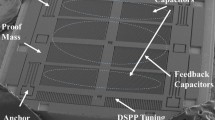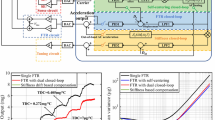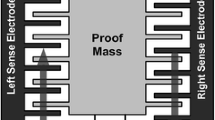Abstract
The bias drift of a micro-electro-mechanical systems (MEMS) accelerometer suffers from the 1/f noise and the temperature effect. For massive applications, the bias drift urgently needs to be improved. Conventional methods often cannot address the 1/f noise and temperature effect in one architecture. In this paper, a combined approach on closed-loop architecture modification is proposed to minimize the bias drift. The modulated feedback approach is used to isolate the 1/f noise that exists in the conventional direct feedback approach. Then a common mode signal is created and added into the closed loop on the basis of modulated feedback architecture, to compensate for the temperature drift. With the combined approach, the bias instability is improved to less than 13 μg, and the drift of the Allan variance result is reduced to 17 μg at 100 s of the integration time. The temperature coefficient is reduced from 4.68 to 0.1 mg/°C. The combined approach could be useful for many other closed-loop accelerometers.
Similar content being viewed by others
References
Aaltonen, L., Halonen, K., 2009. Continuous-time interface for a micromachined capacitive accelerometer with NEA of 4 μg and bandwidth of 300 Hz. Sens. Actuat. A, 154(1):46–56. [doi:10.1016/j.sna.2009.07.011]
Allan, D.W., 1966. Statistics of atomic frequency standards. Proc. IEEE, 54(2):221–230. [doi:10.1109/PROC.1966.4634]
Amini, B.V., Abdolvand, R., Ayazi, F., 2006. A 4.5-mW closed-loop ΔΣ micro-gravity CMOS SOI accelerometer. IEEE J. Sol.-State Circ., 41(12):2983–2991. [doi:10.1109/JSSC.2006.884864]
Chae, J., Kulah, H., Najafi, K., 2005. A CMOS-compatible high aspect ratio silicon-on-glass in-plane micro-accelerometer. J. Micromech. Microeng., 15(2):336–345. [doi:10.1088/0960-1317/15/2/013]
Cui, J., Guo, Z.Y., Yang, Z.C., et al., 2011. Electrical coupling suppression and transient response improvement for a microgyroscope using ascending frequency drive with a 2-DOF PID controller. J. Micromech. Microeng., 21(9):1–11. [doi:10.1088/0960-1317/21/9/095020]
Dong, Y., Kraft, M., Redman-White, W., 2007. Higher order noise-shaping filters for high-performance micromachined accelerometers. IEEE Trans. Instrum. Meas., 56(5):1666–1674. [doi:10.1109/TIM.2007.904477]
Dong, Y., Zwahlen, P., Nguyen, A.M., et al., 2010. High performance inertial navigation grade sigma-delta MEMS accelerometer. Proc. IEEE/ION Position Location and Navigation Symp., p.32–36. [doi:10.1109/PLANS.2010.5507135]
Enz, C.C., Temes, G.C., 1996. Circuit techniques for reducing the effects of OP-AMP imperfections: autozeroing, correlated double sampling, and chopper stabilization. Proc. IEEE, 84(11):1584–1614. [doi:10.1109/5.542410]
IEEE, 1998. IEEE Standard Specification Format Guide and Test Procedure for Single-Axis Interferometric Fiber Optic Gyros. IEEE Std 952-1997. [doi:10.1109/IEEESTD.1998.86153]
Josselin, V., Touboul, P., Kielbasa, R., 1999. Capacitive detection scheme for space accelerometer applications. Sens. Actuat. A, 78(2–3):92–98. [doi:10.1016/S0924-4247(99)00227-7]
Kajita, T., Moon, U.K., Temes, G.C., 2002. A two-chip interface for a MEMS accelerometer. IEEE Trans. Instrum. Meas., 51(4):853–858. [doi:10.1109/TIM.2002.803508]
Karabalin, R.B., Villanueva, L.G., Matheny, M.H., et al., 2012. Stress-induced variation in the stiffness of micro- and nanocantilever beams. Phys. Rev. Lett., 108:236101. [doi:10.1103/PhysRevLett.108.236101]
Ko, H., Cho, D.D., 2010. Highly programmable temperature compensated readout circuit for capacitive microaccelerometer. Sens. Actuat. A, 158(1):72–83. [doi:10.1016/j.sna.2009.12.017]
Lakdawala, H., Fedder, G.K., 2004. Temperature stabilization of CMOS capacitive accelerometers. J. Micromech. Microeng., 14(4):559–566. [doi:10.1088/0960-1317/14/4/017]
Lee, J., Rhim, J., 2012. Temperature compensation method for the resonant frequency of a differential vibrating accelerometer using electrostatic stiffness control. J. Micromech. Microeng., 22(9):1–11. [doi:10.1088/0960-1317/22/9/095016]
Lee, K., Takao, H., Sawada, K., et al., 2003. A three-axis accelerometer for high temperatures with low temperature dependence using a constant temperature control of SOI piezoresistors. Proc. 16th IEEE Annual Int. Conf. on Micro Electro Mechanical Systems, p.478–481. [doi:10.1109/MEMSYS.2003.1189790]
Li, M., Horsley, D.A., 2014. Offset suppression in a micromachined Lorentz force magnetic sensor by current chopping. J. Microelectromech. Syst., 23(6):1477–1484. [doi:10.1109/JMEMS.2014.2316452]
Liu, D., Chi, X., Cui, J., et al., 2008. Research on temperature dependent characteristics and compensation methods for digital gyroscope. Proc. 3rd Int. Conf. on Sensing Technology, p.273–277. [doi:10.1109/ICSENST.2008.4757112]
Petkov, V.P., Boser, B.E., 2004. Capacitive interfaces for MEMS. In: Baltes, H., Brand, O., Fedder, G.K., et al. (Eds.), Enabling Technology for MEMS and Nanodevices. Wiley-VCH Weinheim, p.49–92. [doi:10.1002/9783527616701.ch3]
Prikhodko, I.P., Trusov, A.A., Shkel, A.M., 2013. Compensation of drifts in high-Q MEMS gyroscopes using temperature self-sensing. Sens. Actuat. A, 201:517–524. [doi:10.1016/j.sna.2012.12.024]
Samarao, A.K., Ayazi, F., 2012. Temperature compensation of silicon resonators via degenerate doping. IEEE Trans. Electron Dev., 59(1):87–93. [doi:10.1109/TED.2011.2172613]
Schreier, R., 1993. An empirical study of high-order singlebit delta-sigma modulators. IEEE Trans. Circ. Syst. II, 40(8):461–466. [doi:10.1109/82.242348]
Willemenot, E., Touboul, P., 2000. On-ground investigation of space accelerometer noise with an electrostatic torsion pendulum. Rev. Sci. Instrum., 71(1):302–309. [doi:10.1063/1.1150197]
Wongkomet, N., Boser, B.E., 1998. Correlated double sampling in capacitive position sensing circuits for micromachined applications. Proc. IEEE Asia-Pacific Conf. on Circuits and Systems, p.723–726. [doi:10.1109/APCCAS.1998.743923]
Wortman, J.J., Evans, R.A., 1965. Young’s modulus, shear modulus, and Poisson’s ratio in silicon and germanium. J. Appl. Phys., 36(1):153–156. [doi:10.1063/1.1713863]
Wu, J., Fedder, G.K., Carley, L.R., 2004. A low-noise lowoffset capacitive sensing amplifier for a \(50 - \mu g/\surd Hz\) monolithic CMOS MEMS accelerometer. IEEE J. Sol.-State Circ., 39(5):722–730. [doi:10.1109/JSSC.2004.826329]
Yoshida, Y., Kakuma, H., Asanuma, H., et al., 2005. A linear model based noise evaluation of a capacitive servo-accelerometer fabricated by MEMS. IEICE Electron. Expr., 2(6):198–204. [doi:10.1587/elex.2.198]
Zheng, X., Jin, Z., Wang, Y., et al., 2009. An in-plane low-noise accelerometer fabricated with an improved process flow. J. Zhejiang Univ.-Sci. A, 10(10):1413–1420. [doi:10.1631/jzus.A0820757]
Author information
Authors and Affiliations
Corresponding author
Additional information
ORCID: Ming-jun MA, http://orcid.org/0000-0002-2012-8699
Rights and permissions
About this article
Cite this article
Ma, Mj., Jin, Zh. & Zhu, Hj. A combined modulated feedback and temperature compensation approach to improve bias drift of a closed-loop MEMS capacitive accelerometer. Frontiers Inf Technol Electronic Eng 16, 497–510 (2015). https://doi.org/10.1631/FITEE.1400349
Received:
Accepted:
Published:
Issue Date:
DOI: https://doi.org/10.1631/FITEE.1400349




